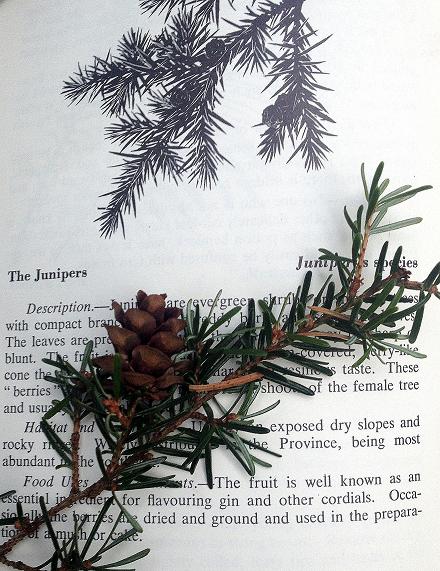 My co-worker and fellow creative lunatic Carol recently asked me what I considered to be the best, most easily accessible books on Wescoast foraging. She’d been poking around the backyard, getting excited about harvesting some local spring plants to eat and wanted a guide that could: a) Give her a fundamental understanding of foraging – ie. when and where to pick what. b) Clearly identify what plants are edible and what to avoid. c) Inspire her to roam farther afield for new experiences.
My co-worker and fellow creative lunatic Carol recently asked me what I considered to be the best, most easily accessible books on Wescoast foraging. She’d been poking around the backyard, getting excited about harvesting some local spring plants to eat and wanted a guide that could: a) Give her a fundamental understanding of foraging – ie. when and where to pick what. b) Clearly identify what plants are edible and what to avoid. c) Inspire her to roam farther afield for new experiences.
I’m only a weekend weed-eater, a total novice, but I’ve got a couple books in my back pocket that have worked well for me and a group of more hardcore foraging friends to hit up for recommendations. Toni and Mark both spend a lot of time out in the scrub and were kind enough to share the books that have helped guide them safely through many bushcrafty adventures (sometimes with yours truly in tow).
Now, everybody’s ‘gonna have a different set of criteria for their ideal guide. No two people’s preferences are alike and their experiences out there amongst the pines will vary wildly (pun sort of intended). Here’s what I personally require in a Wescoast foraging guide:
Full Colour Pictures – I need to know exactly what I’m looking at, and soon to be eating. I find that illustrated guides (though very pretty) just don’t give me the same preciseness of identification that big, close-up, in your face, Technicolor photos do.
Down To Earth Experience – Muddy boots are a must! An author that has stumbled through the same thickets that I have will know how to describe where to look for something better than another author who works a desk job at the botany department. If they stick to plain English and avoid strings of hardcore botany terms, that’s a bonus!
A Link To The Past – Foraging or “bushcraft” or “wildcraft” or whatever you want to call it is all about people getting together with other people and passing on our accumulated knowledge of the natural, edible world. Some of the principles of wild food cultivation and medicine go back thousands of years and a guide that slips in bits of that rich ancient lore totally ignites my imagination.
Having said all of that stuff about everybody being different… Well… *laughs* There was a unanimous consensus amongst us bushwhackers as to what guide was the best. Hands down, the guide that met and exceeded all my requirements was:
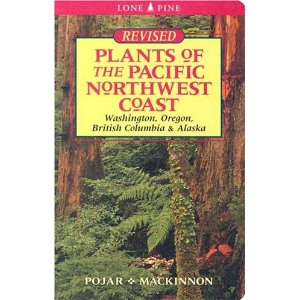 Plants of the Pacific Northwest Coast by Andy Mackinnon and Jim Pojar
Plants of the Pacific Northwest Coast by Andy Mackinnon and Jim Pojar
Both Toni and Mark recommended this book without any hesitation, and with very good reason! Casually flipping through Mark’s battered copy I learned more about what grows ‘round here than a two hour long wildcrafting class I once took. Each chapter details a different species of plant (ie. trees, shrubs, wildflowers, aquatics, etc.) broken into family groups and even smaller into specific regional varieties. It’s an intuitive system, making it easy to flip to exactly the type of plant you’re looking at, and then refine your search as quickly as possible. It’s got a big full colour picture of each plant as well as line drawings of the details and a diagram explaining where along the coast it grows. There is a blurb accompanying each pic, explaining how the plant matures, where, when and why you should care, plus notes on medicinal plant use and even a glossary of First Nations plant names. It’s got it all!
Well, that’s Carol’s question answered… We’re done here. Who’s for a beer?
Nah, I’m kidding. There are a couple of other suggestions I’d like to throw out there:
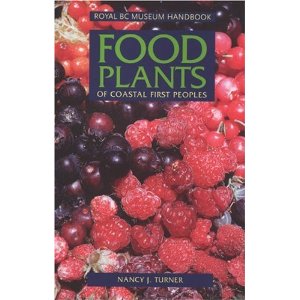 Food Plants of Coastal First Peoples by Nancy Turner
Food Plants of Coastal First Peoples by Nancy Turner
This guide takes the wide lens of Plants Of the Pacific…and focuses it more intensely on a smaller group of traditional Westcoast First Nation foods . There is a lot more on harvesting and preparing plants for culinary/medicinal use and an expanded glossary of First Nations terms. It’s a great book on it’s own, but and even better companion to Mackinnon and Pojar’s book; mixing a bit of history in with all that taxonomy.
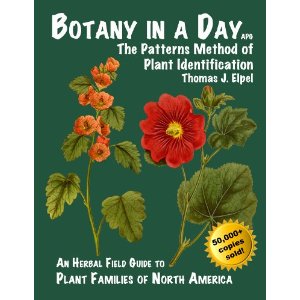 Botany In a Day: The Patterns Method of Plant Identification by Thomas J. Elpel
Botany In a Day: The Patterns Method of Plant Identification by Thomas J. Elpel
Speaking of taxonomy : Toni wisely suggested that if I’m all for foraging on my own I should have a basic understanding of plant species and be able to (at least) identify one from another. It’s fine to know that a tree is a tree, but altogether a more impressive feat to confidently identify a salmonberry bush just from the shape of it’s stems in spring. To rock this kind of knowledge you need a solid foundation, and that’s where this gem comes in. Using a series of seven patterns, the reader can compare certain identification markers to place any plant on the continent into it’s proper family, and then move in for a closer look. My Grandpa Joe would approve this method.
Mushroom hunting is a whole other beast with it’s own set of surprises (and dangers!) for novice foragers. Here’s what I suggest:
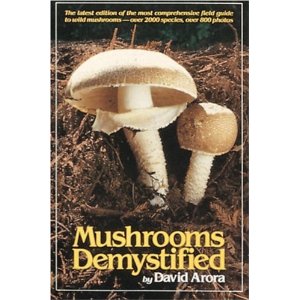 Mushrooms Demystified by David Arora
Mushrooms Demystified by David Arora
If Mackinnon and Pojar’s book is the standard for Westcoast plant foraging, then Arora’s masterpiece is the standard for mushroom hunters all over North America. Everybody knows this guy, and has a ratty copy of his guide in the back of their truck. It’s packed full of clear, beautiful pictures and lots of content on where to hunt (Think about the trees in the area, and the soil, etc.) and what to avoid (It looks like a chanterelle, but…) Aside from all the tips, the best thing about Arora’s writing is his humour and love of anecdote which keeps the book alive and inviting to read anywhere, anytime. How many other guides have poetry in them? This is the bigger brother to Arora’s All That The Rains Promise… Which was my very first foraging guide and another highly recommended book… I wonder what ever happened to it?
If none of the above tomes are available, then there are always the excellent Peterson Field Guides. My brother Andrew and sister from another mister Julie sent me a complete Plants of the East Coast set which I have used and deeply treasured.
Hank Shaw, one of my favourite foraging/food bloggers suggests many other great, more California-centric foraging guides over at Hunter, Angler, Gardener, Cook.
Well, I’d say that’s about it. Big love to Carol for the initial conversations on foraging, I hope you get as much use out of these guides as we have! More love to Toni (The un-official creative director and spiritual guru of this blog) and Mark (Hope you get up the mountain buddy!) for all the great suggestions.
I’m excited to hear what other suggestions people have, what guides they use, and where exactly they’ve found the best pine mushrooms… Anyone?